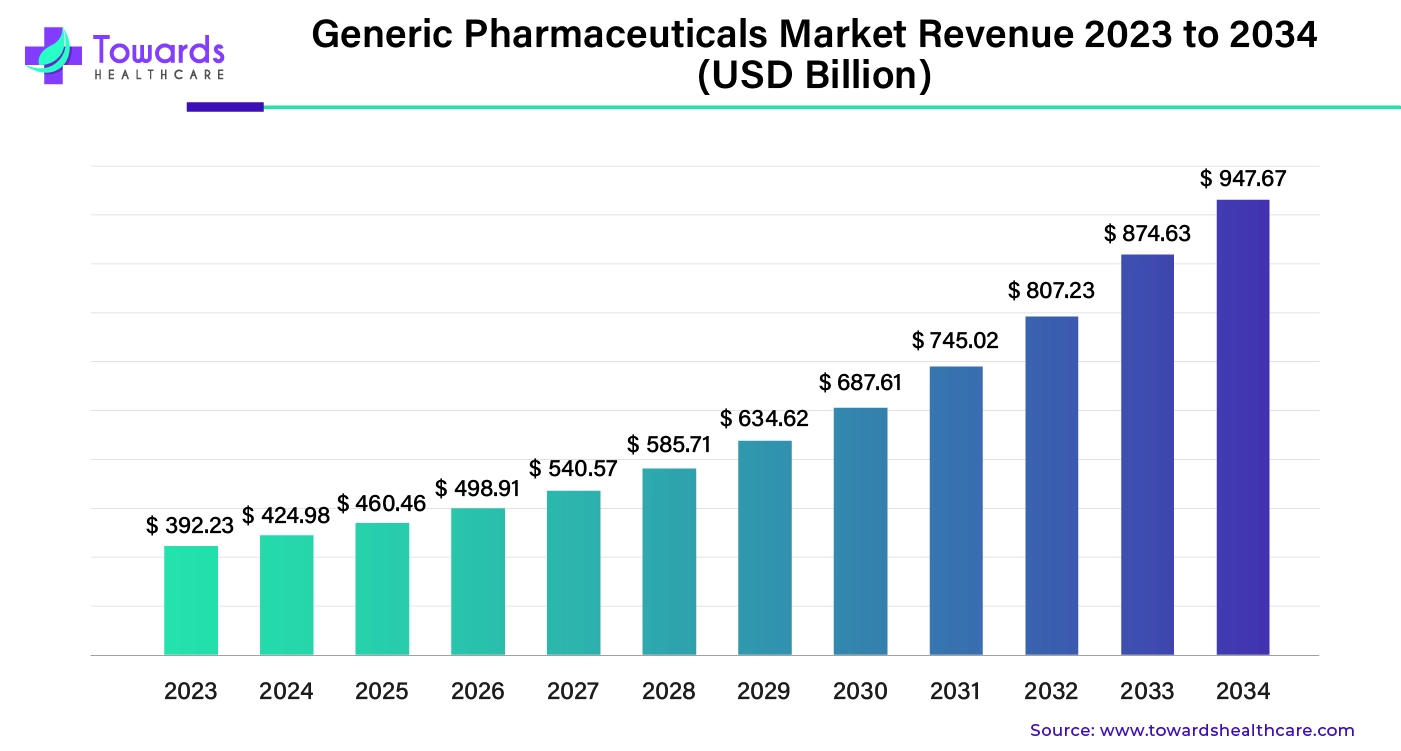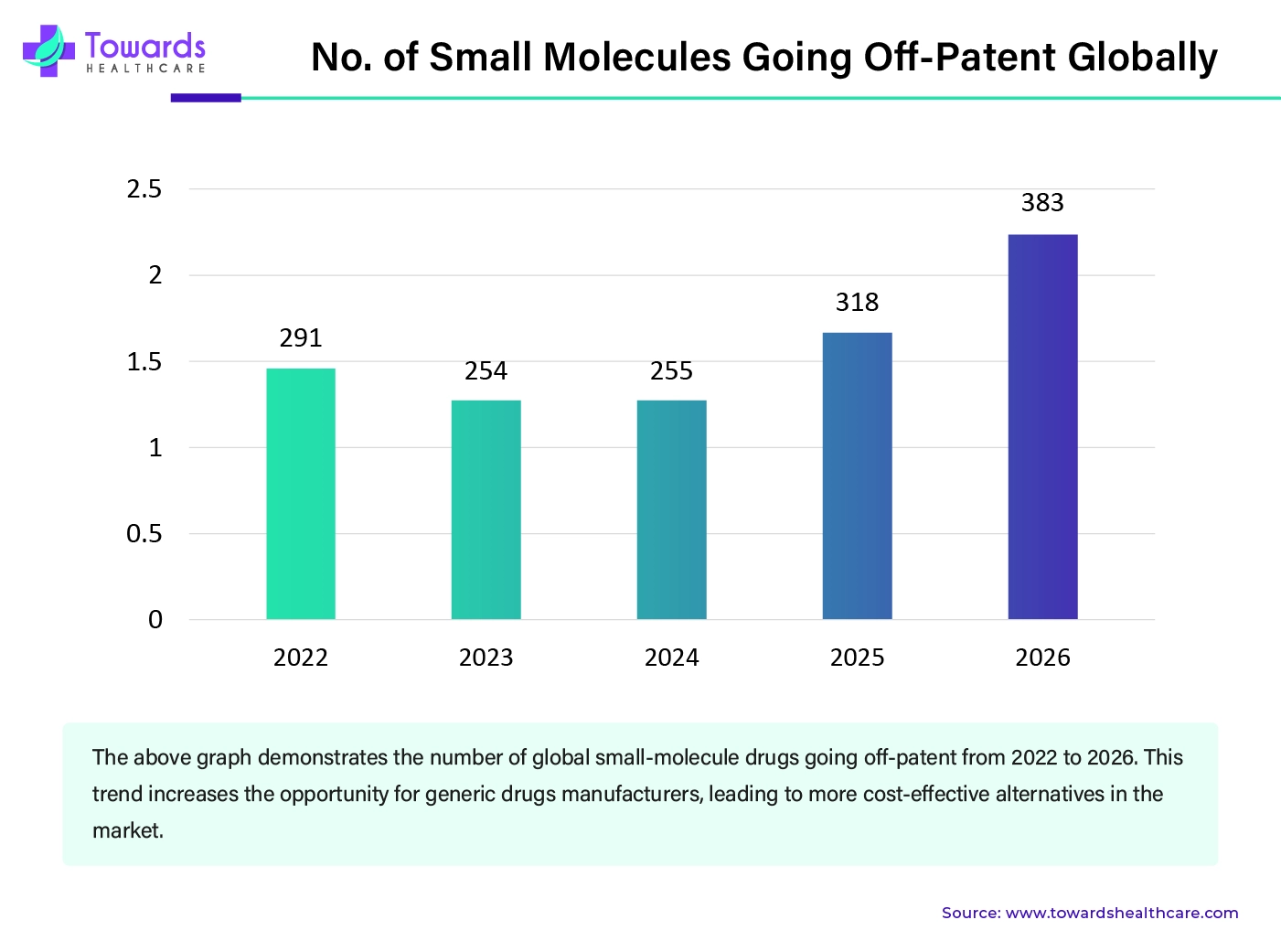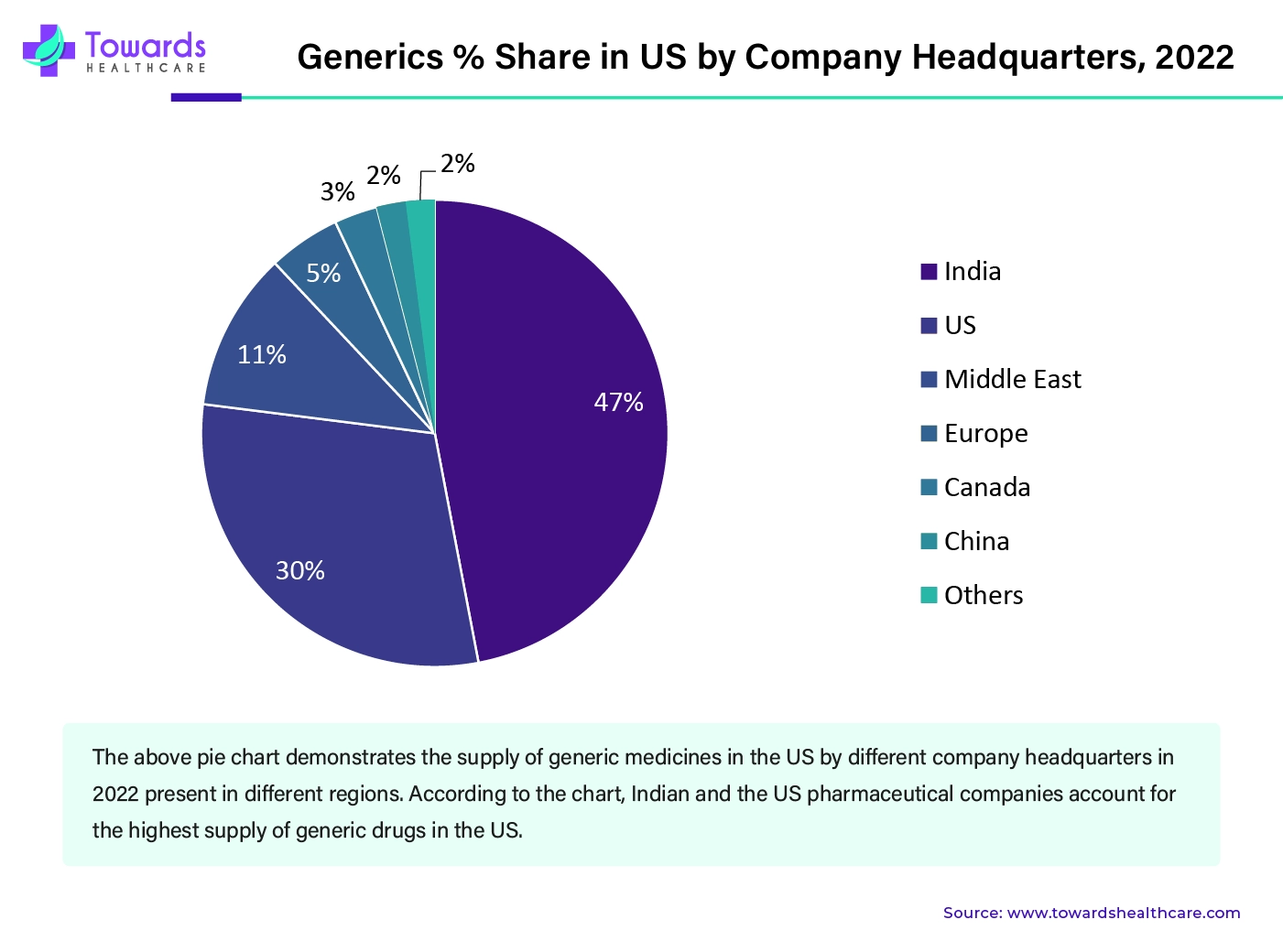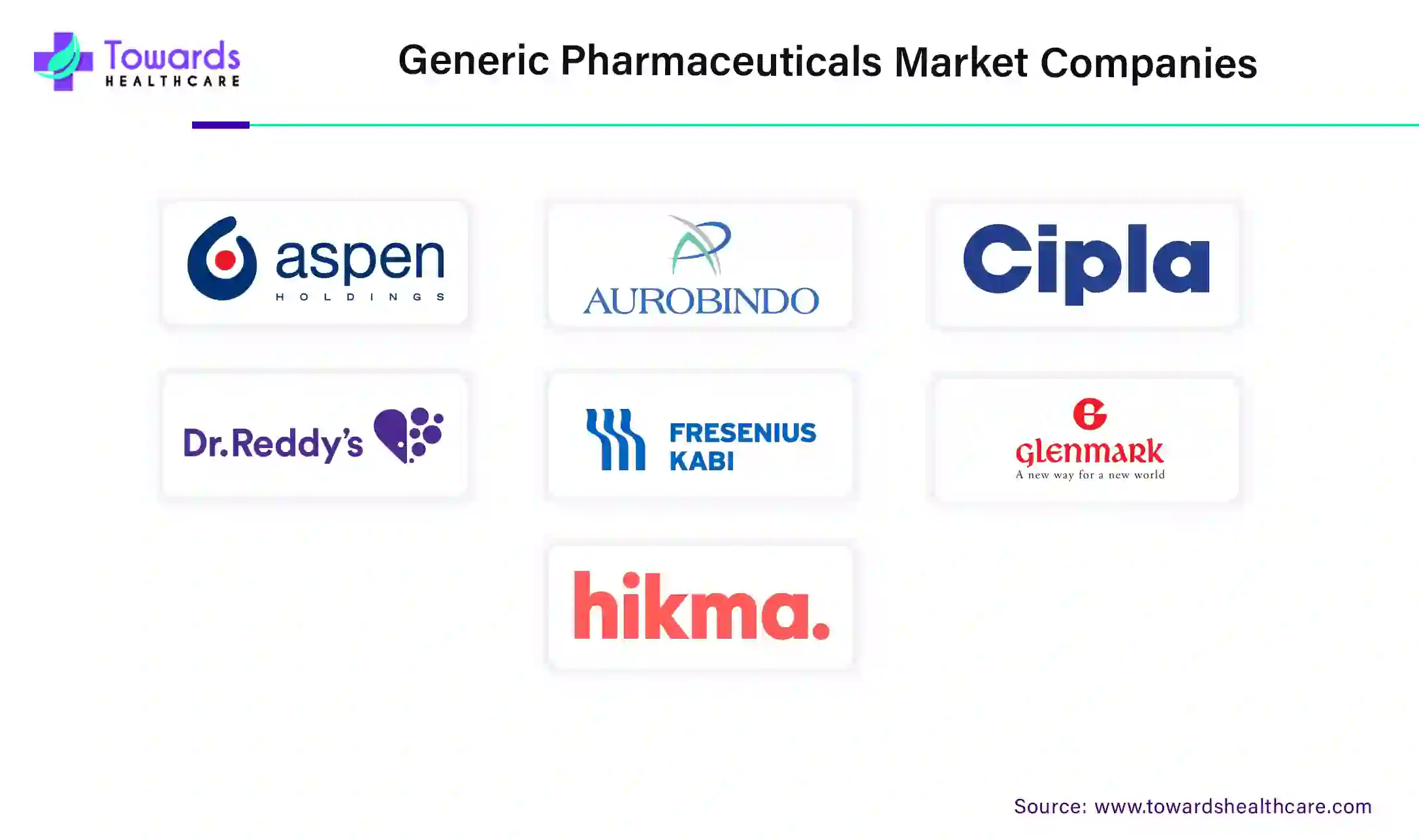April 2025


Principal Consultant

Reviewed By
The generic pharmaceuticals market was estimated at US$ 392.23 billion in 2023 and is projected to grow to US$ 947.67 billion by 2034, rising at a compound annual growth rate (CAGR) of 8.35% from 2024 to 2034. The rise in patent expiration, increasing demand for cost-effective and efficient medicines, and less complex approval process for generics drive the market growth. Generic medicines also don’t require much R&D, which reduces the overall production and development costs.

Generic pharmaceuticals are drug products that contain the same active ingredients of the same strength as that of their brand drugs. According to the US FDA, generic drugs are bioequivalent to brand-name drugs in dosage form, safety, route of administration, quality, performance characteristics, and intended use. Hence, these generics work similarly and provide the same clinical benefits and risks as their brand-name counterpart. These drugs contain different excipients, colors, and flavors to distinguish them from the original ones. The corresponding regulatory agencies approve these generics in the country where they are marketed. Generic pharmaceuticals are sold only when the patent protection ends, usually twenty years, or the patent owner waives its rights. They are comparatively cheaper than brand drugs since they do not undergo preclinical and clinical trials to demonstrate their safety and effectiveness. Additionally, the company that produces generics did not need to invest money in its marketing.
Artificial intelligence (AI) revolutionizes the pharmaceutical sector by implementing modernization and automation in various fields. AI can enable researchers to optimize drug design, develop formulations, and streamline clinical trials more accurately and efficiently. AI in the generic pharmaceuticals market can streamline the process and reduce the time it takes for generic drugs to reach the market. Predictive analysis and natural language processing (NLP) can be used to find compounds similar to those of brand-name drugs to make generic drugs. The machine learning algorithm can be used to determine the solubility of a compound to make sure it maintains its effectiveness over time. AI can also be used to determine the crystal structure of the drug compound. The crystal structure of the drug compound can affect the manufacturing of the drug, producing the drug with sufficient structural integrity so that it does not break down and stays effective.

The bar chart illustrates the estimated savings from generic drug approvals over five years, from 2018 to 2022, with savings calculated based on sales in the 12 months following each approval year. Each bar represents total savings, with a breakdown of "first generic" savings highlighted in a darker shade.
Generic pharmaceuticals are drugs that contain the same active ingredients as those of their brand-name drugs. Generics are generally 80-85% cheaper. They require approval by the respective regulatory agencies to be marketed in that particular country. Generic pharmaceuticals undergo testing for quality, strength, purity, and potency to show effectiveness before being approved. They do not undergo preclinical (animal) and clinical (human) trials to prove their effectiveness. Additionally, the company selling the generic drug does not market the product. Hence, these reduce the cost of a product. The demand for generics increases as payers and consumers seek ways to cut healthcare costs. The US healthcare spending grew by 4.1% to reach $4.5 trillion in 2022. Hence, the rising healthcare costs increase the demand for generics. According to the US FDA report, the estimated savings in the US was around $16.6 billion in 2021.
The huge demand for generic pharmaceuticals requires efficient supply to the consumers. However, the supply chain gets disrupted due to COVID-19, geopolitical issues, and other reasons, resulting in less amount of products reaching the market. Another major challenge is the deteriorating economics. Some pharmaceutical companies face a fall in profit margins, negatively impacting private consumption, investment, and economic growth. Additionally, the disrupted supply chain increases drug shortages, thereby increasing the loss of the manufacturers.
New drugs are patent-protected, which usually lasts for 20 years. Hence, only the company with the patent can sell the drug. Once the patent expires, a generic version of the drug can be made by other companies and approved by the respective regulatory agencies in which the drug is to be sold. Patent expiration provides significant opportunities for generics manufacturers. According to a report by KPMG, the patent expirations of total small-molecule drugs will nearly double by 2026. The most common therapeutic areas for generic drugs include oncology, central nervous system disorders, anti-infectives, and gastrointestinal disorders. Hence, more generic pharmaceuticals can be launched in the market with the expiration of patents over the coming years.

The biosimilars segment is expected to grow at the fastest rate in the generic pharmaceuticals market during the forecast period of 2024 to 2034. Biosimilars are drugs that are very close in structure and function to biological medicine. Biologics are drugs that are derived from living organisms like yeast, bacteria, or animal cells. Some examples of biologics include immunotherapy, stem-cell and gene therapy products, insulin, and monoclonal antibodies. However, unlike simple generics, biosimilars undergo extensive analysis and clinical trials to confirm that they have the same characteristics as the reference biologics. The demand for biosimilars increases as it is derived from natural sources and is available at a much lower cost than biologics. According to the Association for Accessible Medicines report, biosimilars are expected to save approximately $133 billion by 2025.
The cardiovascular diseases segment led the global generic pharmaceuticals market in 2023. Some examples of cardiovascular disorders include hypertension, coronary heart disease, cerebrovascular disease, peripheral arterial disease, deep vein thrombosis, and pulmonary embolism. According to the WHO, an estimated 17.9 million people die from cardiovascular disorders each year globally. The average medication cost of a heart patient accounts for thousands of dollars annually. Hence, the use of generics lessens the financial burden on the lower- and middle-income groups of people, thereby increasing the affordability of cardiovascular drugs.
For instance,
The cancer segment is anticipated to grow with the fastest CAGR in the generic pharmaceuticals market during the studied years. The rising cancer cases and the high cost of hospitalization shift the patient demands towards generic pharmaceuticals. Some common generic drugs available to treat cancer include cisplatin, carboplatin, and methotrexate. It reduces the cost by 40-50% compared to the brand-name drugs. At the same time, some common biosimilars include Filgrastim, Bevacizumab, and Trastuzumab. It reduces the cost by 15-20% compared to biologics. It benefits the patients by reducing the total healthcare cost.
The small molecule segment registered its dominance over the global generic pharmaceuticals market in 2023. Conventional small molecules take around 10-15 years to enter the market, from their discovery to market approval. However, small molecule generics do not undergo such complex approval steps. The development and manufacturing processes are, in most cases, straightforward. Small molecule generics are manufactured once the patent of brand-name drugs expires. Generic manufacturers only need to prove that the product contains an identical chemical composition and similar pharmacokinetic properties. Hence, the simpler approval process of small molecule generics, increase in patent expiration of small molecules, and low cost of products drive the market.
The large molecule segment will grow at a significant rate in the generic pharmaceuticals market over the studied period of 2023 to 2034. Large molecule generics are typically called biosimilars. The increasing patents on biologics, rising demand for natural products as medicines, and low cost of biosimilars boost the market. The rising cases of infectious disorders, cancer, cardiovascular disorders, and hematological disorders increase the use of biologics such as vaccines, blood components, gene therapies, and other complex and expensive products. Hence, biosimilars are widely preferred in such cases as they reduce the cost by one-third than that of their biologic counterparts.
The oral segment dominated the generic pharmaceuticals market globally in 2023. Oral administration is the most common route of administration for drug delivery due to patient compliance and ease of use. Around 84% of the best-selling pharmaceutical products are orally administered. The drug release can be manipulated in the case of oral drugs by preparing sustained-release and immediate-release tablets or capsules. The novel innovations in drug delivery formulations facilitate the targeted delivery and enhanced drug absorption at the desired time within the body. This increases the demand for oral drugs. The oral generics are comparatively cheaper and provide the same desired effect, thereby increasing their preference.
The injectable segment is predicted to witness notable growth in the generic pharmaceuticals market over the coming years. Injectable drugs are administered directly into the body fluids for faster action. The rising demand for complex and large molecules increases the use of injectables, as these molecules can only be administered through injections. According to the US FDA, approximately 42% of new molecular entities and 47% of all newly approved products in the last ten years have been injectables. The generic injectables market also sees growth due to lesser competition and price efficiency than the brand-name injectables.
The retail pharmacy segment accounted for a dominant share of the generic pharmaceuticals market in 2023. Patients generally prefer buying generics from retail pharmacies. The primary reason is the availability of retail pharmacies in nearby areas. There are 45,311 pharmacies and drug stores in the US, with more than 90% of Americans living within 5 miles of a pharmacy. Retail pharmacies also provide facilities such as the presence of trained personnel, home delivery, 24x7 facilities, and special discounts. All these aspects boost the retail pharmacy segment.
The online pharmacy segment is estimated to grow fastest during the forecast period. The demand for online pharmacies increases due to the ease of ordering drugs in the comfort of homes. Recent technological advancements and the advent of the Internet age have increased the demand for online pharmacies. They also offer virtual appointments with physicians or trained personnel.
North America dominated the global generic pharmaceuticals market share by 36% in 2023. The rising demand for generic products, favorable government policies, and capital investment drive the market. The US has the biggest market for generic pharmaceuticals in the world. Generics account for 91% of prescriptions dispensed in the U.S. but only 18% of the total drug costs, making them a vital part of the US healthcare system. The US Government’s Food and Drug Administration imposes stringent regulations and policies regarding the approval of generic medicines. The increasing number of drug approvals also boost the market. In 2022, Congress authorized the Generic Drug User Fee Amendments (GDUFA) III. The FDA aimed to promote scientific research through the GDUFA Science and Research Program in 2022. The program can help to understand the FDA’s understanding of generic drugs and develop advanced methods to characterize product quality and performance.
For instance,

Asia-Pacific is estimated to be the fastest-growing market during the forecast period. The low cost of generic pharmaceuticals, rising patent expiration, increasing awareness about generics, and presence of key players drive the market. India and China are at the forefront of driving the generic pharmaceuticals market in the region. Indian pharmaceutical companies are exporting generic drugs to the US market, accounting for 47% of all generic prescriptions supplied by Indian companies in 2022. India manufactures around 60,000 different generic brands across 60 therapeutic categories. It exports pharmaceuticals to over 200 countries. Additionally, government initiatives like “Pradhan Mantri Bharatiya Janaushadhi Pariyojna” to sell high-quality generic medicines to the people augment the market. It has been reported that more than 95% of China’s 170,000 drugs are generic. The presence of key players in India and China leads to the highest generic drug manufacturing globally. Also, the availability of raw materials in China boosts the market. Many large generic drugmakers get 55% of their raw materials from China.

| Company Name | Teva Pharmaceuticals, Inc. |
| Headquarters | Tel Aviv-Yafo, Israel |
| Recent Development | In June 2024, Teva Pharmaceuticals announced the launch of its generic Victoza (Liraglutide injection 1.8 mg) in the US. It is the first-ever generic GLP-1 product in the US marketplace. The drug improves glycemic control with type 2 diabetes mellitus and reduces the risk of cardiovascular events. |
| Company Name | Zydus Lifesciences |
| Headquarters | Ahmedabad, India |
| Recent Development | In September 2024, Zydus Lifesciences announced that it received US FDA approval to manufacture Enzalutamide capsules (40 mg). It is an androgen receptor inhibitor for the treatment of metastatic castration-resistant prostate cancer. |
Richard Saynor, CEO of Sandoz, commented that Switzerland could save millions on medicine by increasing the use of generic medicines. The generics and biosimilars have a market share of only 25% in Switzerland, while it is 70% in the entire Europe. He also added that the use of generics could relieve massive healthcare costs and provide more space to finance innovative new active ingredients in the pharmaceutical industry. He announced that the company has 25 biosimilars in the pipeline, and in the next eighteen months, five more biosimilars will be launched in the US and Europe.
By Type
By Application
By Product
By Route of Administration
By Distribution Channel
By Region
April 2025
April 2025
March 2025
March 2025